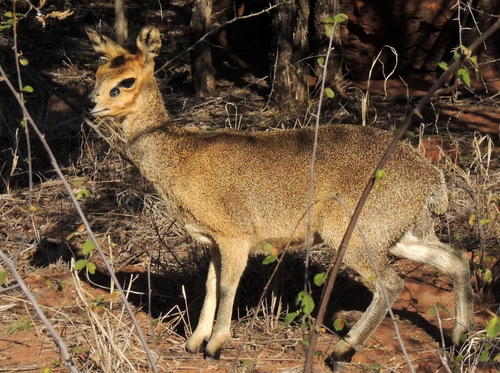
Klipspringer
The klipspringer, Oreotragus oreotragus, is a nimble rock-climber of Africa, perfectly adapted to rugged terrains. Its specialized hooves provide grip on steep slopes, while its bristly coat camouflages against predators. Living in monogamous pairs, klipspringers are a testament to nature’s adaptability and engineering.
15 years
Lifespan
9.97903 - 18.1437 kg
Weight
Length: 75 - 114 cm; Height: 43 - 51 cm
Size
Brown, Grey, Yellow, Olive
Color
7-12 months
Age of Sexual Maturity
4-5 months
Age of Weaning
Low
Aggression
Least Concern
Conservation Status
Stable
Population Trend
Characteristics
Oreotragus oreotragus, commonly known as the klipspringer, is a small antelope native to the rocky hills of sub-Saharan Africa. It features a stocky build, with coarse, bristly fur that blends into its rocky surroundings. Notably, klipspringers have unique hooves adapted for gripping steep, rocky surfaces, and they often exhibit monogamous pair bonding.
Distribution Range of the Klipspringer
Oreotragus oreotragus, commonly known as the klipspringer, is native to sub-Saharan Africa. Their geographical distribution includes countries such as South Africa, Namibia, Angola, Kenya, Tanzania, and Ethiopia. They are found predominantly in eastern and southern Africa.
Klipspringer's Habitat
Environmental Conditions
Klipspringers inhabit rocky terrains, such as mountainous regions, rocky hillsides, and escarpments. These environments typically have sparse vegetation, with conditions that can vary from semi-arid to more temperate climates, depending on the region.
Ecological Niche
The klipspringer is well-adapted to its rocky habitat, with specialized hooves that allow it to navigate steep and uneven surfaces with agility. It primarily feeds on shrubs, succulents, and other hardy vegetation found in its arid habitat. These antelopes are highly territorial and often found in pairs or small family groups, relying on their keen eyesight and elevated vantage points to detect predators.
Copyright @ Nature Style Limited. All Rights Reserved.
 English
English